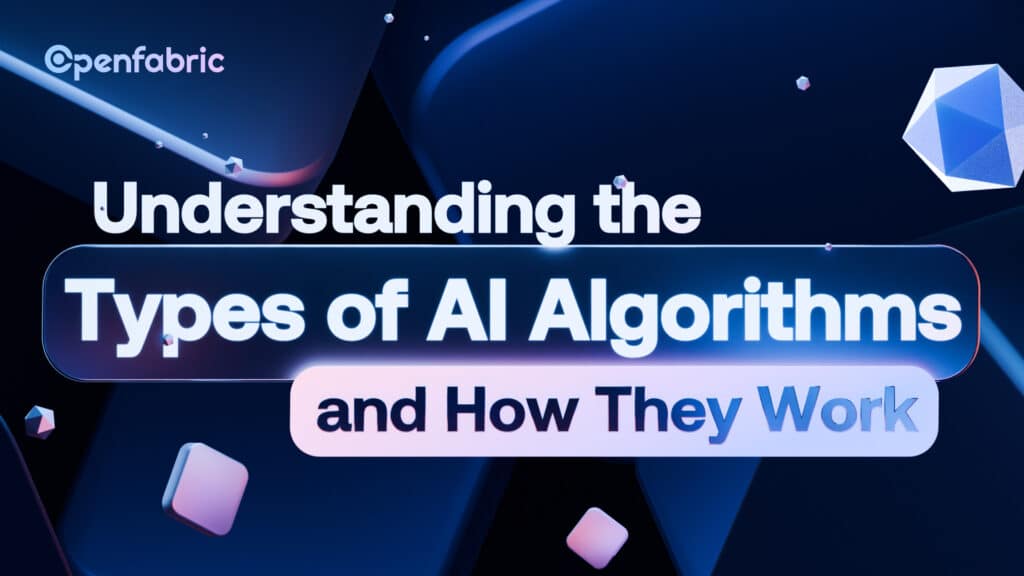
February 7, 2025 6 minutes read
Understanding the Types of AI Algorithms and How They Work

Artificial intelligence is a complex system that uses different systems to work autonomously. This ability to operate autonomously enables the incorporation of AI into various industries and sectors. As such, artificial intelligence can perform tasks that typically require human intelligence. However, the decision-making process that leads to the performance of these complex tasks requires different types of AI algorithms.
Basically, AI systems require AI algorithms to function fully. These algorithms allow the AI system to understand complex patterns, learn from them, and make decisions. Furthermore, AI algorithms lie at the core of AI advancements. Therefore, the performance and operations of an AI system depend on the type of AI algorithm that governs it.
There are several types of AI algorithms and understanding them is important to fully utilize their potential. In this article, we will talk about the different types of AI algorithms and highlight how each of them works.
Let’s get started!
What are AI algorithms?
AI algorithms are a set of instructions and computational procedures that enable AI systems to process data that are important in making decisions or predictions without needing human intervention. They comprise procedures for making calculations or other operations by the AI system. They enable AI-run machines to process data, learn from it, adapt accordingly, and perform a range of tasks from simple calculations to complex problem-solving. So, essentially, an AI algorithm is the programming that tells the computer how to learn to operate on its own.
The AI algorithm is the core of artificial intelligence systems. However, the first thing to remember is that the ability of an AI system entirely depends on the types of AI algorithms within the system.
What are the types of AI algorithms and how do they work?
AI algorithms can perform tasks that would typically require human intelligence, such as recognizing patterns, understanding natural language, problem-solving, and decision-making. There are three main types of AI algorithms. They are broadly classified based on their learning methodologies.
Supervised learning algorithms
In supervised learning, the algorithm trains from a labeled and categorized data set. In this labeled data set, each input data is associated with the correct output. Therefore, with this training method, the algorithm learns to predict the outputs from the new inputs. For instance, a supervised learning algorithm can identify similar pictures without human intervention. The algorithm uses many examples of these similar pictures and those that are not. As such, it can then predict which pictures are similar and sort them accordingly. There are different types of supervised learning algorithms
- Decision tree: It is a branching-shaped chart that represents all the possible outcomes. It is composed of splits or nodes that each represent a different categorization test.
- Random forest: a random forest comprises different decision trees. Each decision tree tests for a different input and the algorithm makes a prediction based on the results of all the decision trees put together.
- Linear regression: a linear regression algorithm is one of the most basic AI algorithms. It makes its predictions based on an independent variable that the algorithm’s operator determines. For example, a linear regression algorithm can predict the number of visitors to a resort community based on the historical data of visitors since the establishment of the resort.
Unsupervised learning algorithms
Unsupervised learning algorithms train using uncategorized and unlabeled data. The algorithm learns from an unlabeled data set by identifying patterns, instead of following instructions. Generally, this approach recognizes patterns which enables the algorithm to determine which categories and labels the data should possess. It is useful when the data set for analysis is not clearly categorized or labeled. The types of unsupervised learning algorithms include:
- K-means clustering: this algorithm aims to sort and categorize data. The “K” is the number of groups or clusters it will sort the data into while the algorithm returns a means variable for each category. It is also known as a hard clustering method.
- Gaussian mixture model (GMM): it works similarly to K-means clustering. However, unlike K-means clustering, it allows for a more flexible and accurate clustering since it can handle multi-modal data. It is also called soft clustering.
Reinforcement learning algorithms
In reinforcement learning, the algorithm adopts a trial-and-error approach to problem-solving. The algorithm interacts with an environment, receiving feedback in the form of “rewards” or “punishment” for its work. By doing so, it adjusts its actions to determine the best way to accomplish its task independently. Although the computer programmers set up the rules for the reward and the punishment, the algorithm chooses the best way to work on the data set.
In addition to these three main types of AI algorithms, hybrid models have been developed. These hybrid models combine the strong elements of the three main algorithms. Some of them include:
- Semi-supervised learning: it combines supervised and unsupervised learning algorithms. It uses a small amount of categorized data and a large amount of uncategorized data to train AI algorithms.
- Self-supervised learning: it is a type of unsupervised learning algorithm where the model creates its label from the data input and then uses the labels for supervised training.
- Model/based reinforcement learning: it uses supervised learning to create a model of the environment, while reinforcement learning makes the decisions.
- Generative adversarial networks: this approach combines unsupervised learning algorithm and supervised learning algorithm competitively to improve accuracy.
Applications and use cases of AI algorithms
AI algorithms have numerous applications across several industries and verticals. Generally, anywhere AI finds an application, AI algorithms are there too. Here are some of the applications of AI algorithms:
- Retail and e-commerce: AI algorithms have the ability to analyze customer behavior for personalized recommendations to customers or optimize pricing. Through chatbots, they can also help automate customer service. The adoption of chatbots is on the rise and their application in retail is evolving. Eventually, chatbots will have emotional intelligence which will enhance their interaction with customers. Read more about this HERE.
- Healthcare: AI algorithms can assist in the diagnosis of medical conditions, drug discovery, and personalized medicine. AI algorithms can also help doctors and other healthcare professionals make better decisions by providing insights from the large amounts of data they possess.
- Energy: AI algorithms are used in smart grid optimizations for energy distribution.
- Finance: AI algorithms have the ability to detect fraud, and do algorithmic trading and financial forecasting. They have the ability to analyze large amounts of financial data to identify patterns or anomalies that might indicate fraudulent activity. In addition, they can also provide useful insight into customer behavior or market trends that allow banks to make better decisions.
- Manufacturing: AI algorithms can analyze sensor data of manufacturing equipment to predict equipment failures before they happen. By doing so, it helps to reduce maintenance costs and improve efficiency.
Conclusion
AI algorithms are more or less the control unit of AI systems. They are the core element in the automation and decision-making process of artificial intelligent systems. More discoveries are still ongoing to see how we can maximize the types of AI algorithms to create more. sophisticated and evolved AI systems.
For more information, visit our WEBSITE today!

